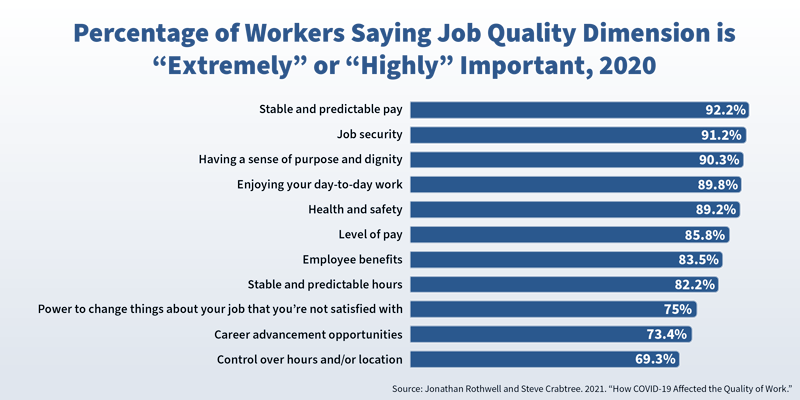We all know workers who have left their jobs in the last few years. Some of them left due to safety concerns or even retired early, while others — especially women — left due to challenges securing childcare. But there are also a lot of people leaving jobs because they want to pursue what they believe will be a better opportunity, also known as a “good job.”
What makes a job “good?”
For some workers, a good job might mean a job where they earn a salary that can support their family. For others, it might be access to a health insurance plan. And for still others, it could involve having a say over how they do their work, including through unions. A 2020 Gallup poll suggests that workers define good jobs through a range of characteristics, with stable and predictable pay, job security and having a sense of dignity and purpose in work topping the list:

A gap in good job data
In the federal government, we track lots of data about jobs. But based on this poll, it’s clear we aren’t tracking many of the key attributes that workers say are most important in a job. Across federal data on jobs collected and reported by the Department of Labor, we focus overwhelmingly on wages. Though workers certainly say pay is important, there are many other job characteristics that appear just as, if not more, important to workers today.
This gap between what workers value and what the government tracks matters. It makes it harder for the department to report on trends in the economy relevant for workers. It also makes it harder for us to understand and pursue strategies for expanding access to good jobs, especially for historically underserved populations.
A new collaboration to bridge the data gap
That’s why we’re proud to announce a new collaboration between the department and a network of leading academic researchers, workforce practitioners, business representatives and philanthropic organizations organized by the Families and Workers Fund. This collaboration, which we formally kicked off last week, will help us understand how we — along with other public, private and research organizations — can work together to better measure, analyze and report on job quality.
This collaboration will complement and reinforce the ongoing work of our Good Jobs Initiative, which is focused on providing critical information to workers, employers and federal agencies as they work to improve job quality and create access to good union jobs.
“What doesn’t get counted doesn’t count”
Network participants are already sharing new ideas for the future of government jobs data. From reporting on schedule predictability and electronic monitoring of workers to the structure of employment arrangements, there’s lots of excitement around collecting and analyzing more data that can be used to improve the lives of America’s workers.
As one participant pointed out, “What doesn’t get counted by the federal government doesn’t count.” For that reason, we’re excited to collaborate with, and learn from, network participants so that we can count more of the aspects of job quality that workers value — and in the process, help ensure that more workers have access to good jobs.
Alexander Hertel-Fernandez is deputy assistant secretary for research and evaluation at the U.S. Department of Labor.
Raj Nayak is assistant secretary for policy at the U.S. Department of Labor.
Teresa Acuña is policy advisor for the office of assistant secretary for policy at the U.S. Department of Labor.
|
|
% Workers Saying Job Quality Dimension is "Extremely" or "Highly" Important |
|||||
|
Control over hours and/or location |
69.3 |
|
|
|
|
|
|
Career advancement opportunities |
73.4 |
|
|
|
|
|
|
Power to change things about your job that you’re not satisfied with |
75 |
|
|
|
|
|
|
Stable and predictable hours |
82.2 |
|
|
|
|
|
|
Employee benefits |
83.5 |
|
|
|
|
|
|
Level of pay |
85.8 |
|
|
|
|
|
|
Health and safety |
89.2 |
|
|
|
|
|
|
Enjoying your day-to-day work |
89.8 |
|
|
|
|
|
|
Having a sense of purpose and dignity |
90.3 |
|
|
|
|
|
|
Job security |
91.2 |
|
|
|
|
|
|
Stable and predictable pay |
92.2 |
|
|
|
|
|

 U.S. Department of Labor Blog
U.S. Department of Labor Blog